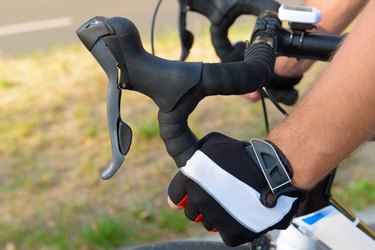
If you've purchased a bike with a Shimano SIS shift system -- which stands for Shimano Indexing System -- you may find yourself confused as to how the shifts work. The system features a large and small shift lever mounted on the left and right handlebars and comes in both 7-speed and 10-speed. You use shift levers to change gears, which makes it harder or easier to pedal. The right shift levers control the rear derailleur, which is mounted next to your back wheel. The left shift lever controls the front gear, which is part of the crank connected to your pedals that drives the chain.
Right Shift Lever
Video of the Day
Step 1
Press the large right shift lever. It's mounted on the right handlebar and is the larger of the two levers. It features a red dial on the small display and is numbered 1 to 7 or 1 to 10, which represents the number of gears. Each time you press the lever, the derailleur moves up the cog incrementally into a less challenging, lower gear, making it easier to ride.
Video of the Day
Step 2
Press the small right shift lever once to shift the derailleur down one position on the cog set. The small shift lever is directly behind the large lever. This shifts the derailleur to a smaller cog, in a higher gear, which makes it more challenging to pedal.
Step 3
Press the large left shift lever once. This moves the drivechain up to the large chainring on the front gear which is connected to your pedals. There are only two chainrings on the front, a large and small one, so the left shift lever possesses only two settings. The large chainring makes it more challenging to pedal. Pressing the small left shift lever moves the drivechain down to the small chainring, which makes it easier to pedal. The small display on the left shift lever features the numbers one and two, which show you which front gear you are in. Adjusting the front and rear gears allows you to customize the speed and effort of your pedaling. An easier gear is good for climbing up a steep hill, while a more challenging gear is good for building endurance on flat terrain.